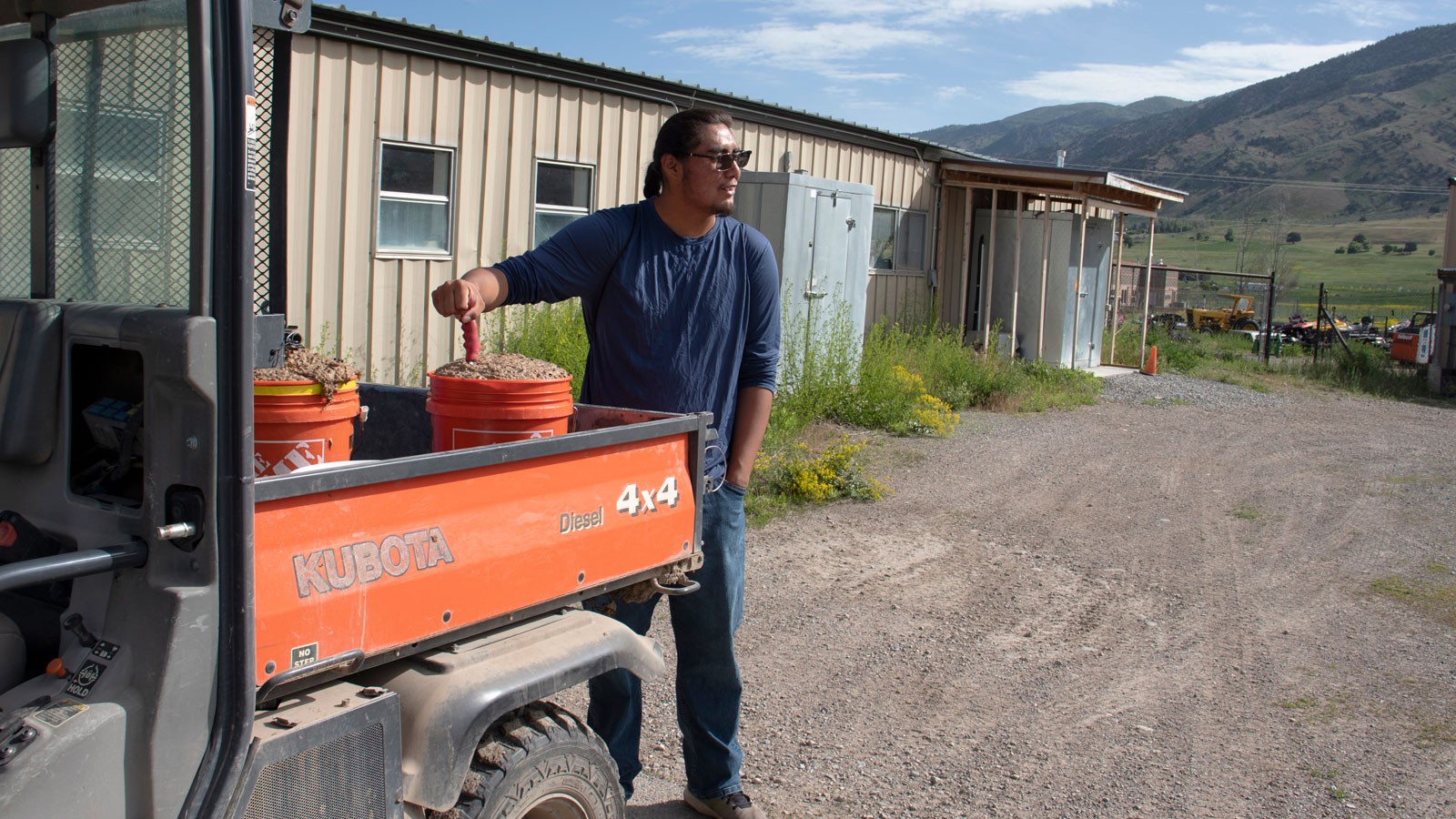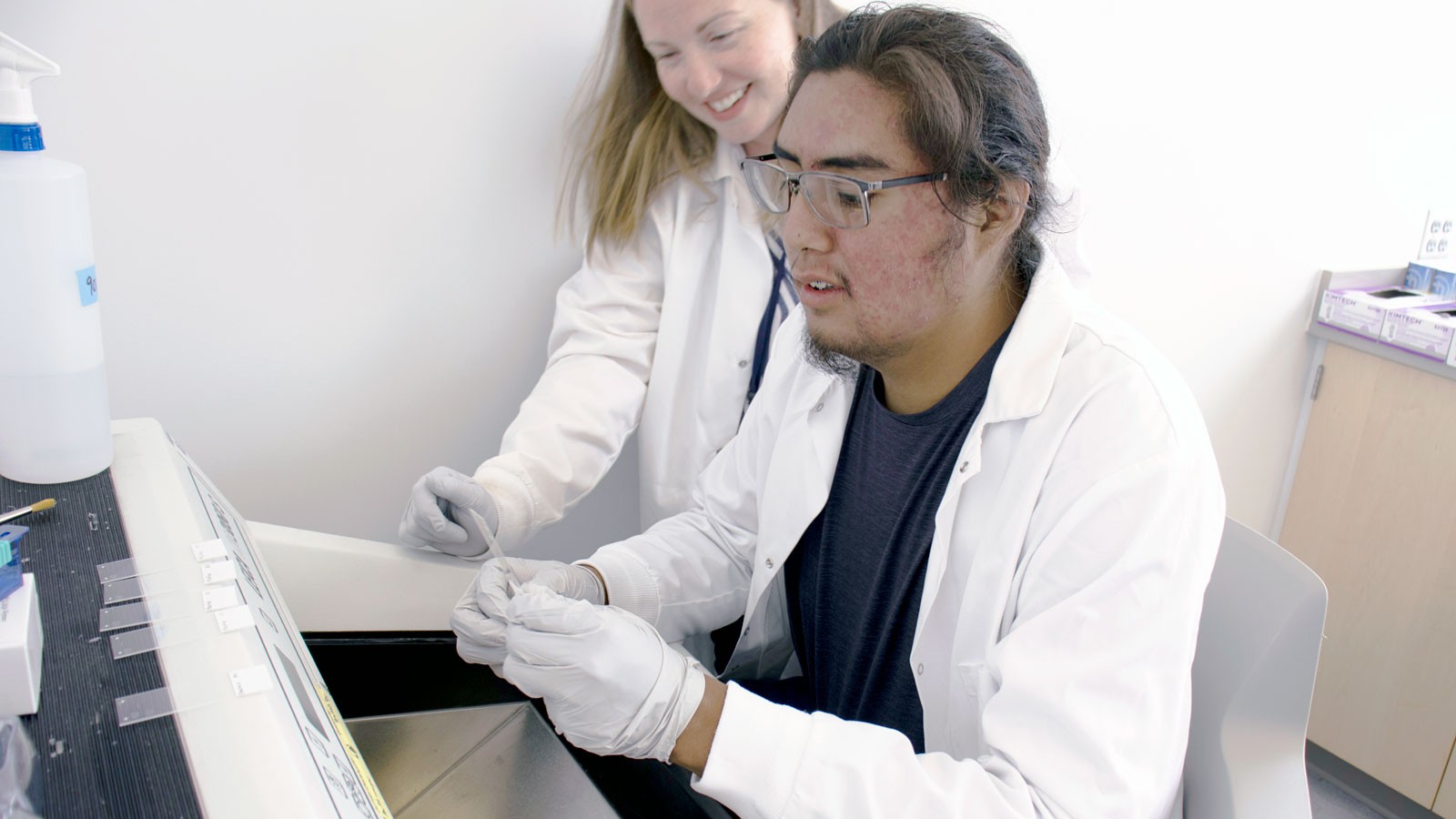Dog Days of Summer: USU Blanding Scholar Explores Wildlife Biology
Tolonqua Nakai studies the social behavior of coyotes at USDA predator research facility.
By Mary-Ann Muffoletto |
At the USDA National Wildlife Research Center Utah Field Station, USU Blanding scholar Tolonqua Nakai readies food for coyote pups. Nakai is a participant in USU's 2023 Native American Summer Mentorship Program. (Photo Credit: USU/M. Muffoletto)
Utah State University Blanding scholar Tolonqua Nakai dreams of heading to the coast.
Which coast?
Any coast that will allow him to study sharks and other oceanic creatures, Nakai says.
“I spend a lot of my time watching documentaries about marine biology,” says the 2022 graduate of Utah’s San Juan High School, who’s working toward an associate degree in biology and serves as a peer mentor at USU Blanding.
For now, the undergraduate is content to work with terrestrial animals, including the Siberian huskies his family raises.
While participating in this month’s Native American Summer Mentorship Program at USU’s Logan campus, Nakai had the opportunity to work with wild canids at the USDA National Wildlife Research Center Utah Field Station, in nearby Millville, Utah, where researchers study coyote ecology and behavior.
NASMP, which was initiated at Utah State in 2014, provides students with an immersive, four-week introduction to four-year degree programs in a range of disciplines, as well as leadership-building activities and information about opportunities beyond undergraduate degrees.
Before heading to the field, Nakai worked with Department of Biology faculty mentor and neuroscientist Sara Freeman, who studies the social behavior of monogamous animals, including coyotes. Freeman is currently pursuing collaborative research with USDA colleagues at the Utah Field Station.
With Freeman, Nakai learned to use an instrument called a cryostat to slice thin sections of brain tissue — practicing with rodent brains — for microscopic analysis.
“This instrument allows us to slice tissue in 20-micron sections,” Freeman says. “That’s about the width of a human hair.”
Acquiring this skill, she says, is essential for studying the neuroanatomy of mammals.
“I never thought I’d be working with actual brains,” Nakai says. “But this and study of animals’ neurobiology builds on favorite topics I studied about evolutionary science in previous classes with Dr. Carla Endres in Blanding.”
Prepped for a two-day field experience to the tightly secured Millville facility (no photos of the coyotes or enclosures allowed), Nakai traveled with Freeman Lab member and doctoral student Caroline Long to work with USU alumna and Colony Specialist Andalyn Billings to learn about the field station’s operations and how research is conducted with the animals.
His first assignment? Feeding the coyote pups a high-protein slurry diet specially formulated for the health and well-being of the fur-producing animals. A tasty treat for the coyotes, the mixture, composed of animal byproducts with additional protein and supplements added, is not quite as appealing to humans.
“It’s not so bad, once you get used to it,” Billings says. “It doesn’t bother me, unless I recognize something specific in it, like a cow’s eyeball.”
“Ewwwwww,” responded Nakai and Long in unison.
“The coyote food smelled, but feeding the coyotes was a fun experience,” Nakai says. “I had only one pup run up to me being curious, and jumping around excitedly with the other pups during feeding time.”
Billings emphasized the importance of keeping the animals well-hydrated; a requirement that Nakai took seriously based on his experiences working with domesticated dogs. He observed that, like his Husky pups, growing coyotes need a lot of water and nutritious food.
Checking each pup’s hydration, as well as weighing each pup to ensure they were receiving proper nourishment, was the next task in which Nakai participated and one he admitted was more challenging than the feeding process.
“We had to get the pups into their dens to take the measurements,” he says. “They were jumpy and pooped a lot, and they tried running from us. Thankfully, they didn’t get past us.”
Nakai says the experience reminded him of trying to catch lively Husky pups.
“Learning how things work in the wildlife biology field has shown me that people who work in these facilities care very much about the animals’ wellbeing,” he says. “They try their best to keep the animals healthy and happy while still collecting as much information for research as possible. The experience makes me want to go into the biology field even more to learn about different creatures we share our planet with and how to coexist.”
While working with coyotes was interesting, Nakai says he still has his mind set on marine biology.
“For now, my main focus is completing my associate degree,” he says. “Then, I’ll focus on a bachelor’s degree.”
NASMP participants will share their research experiences from 9-10:30 a.m. Tuesday, June 13, in the Biology-Natural Resources Lecture Hall, BNR 102. All are welcome.
Undergrad Tolonqua Nakai, right, with biology faculty mentor Sara Freeman, slices sections of rodent brain tissue with a cryostat. Nakai is among nine scholars in USU's 2023 Native American Summer Mentorship Program. (Photo Credit: USU/M. Muffoletto)
WRITER
Mary-Ann Muffoletto
Public Relations Specialist
College of Science
435-797-3517
maryann.muffoletto@usu.edu
CONTACT
Hannah Wilson
Lead Facilitator
Native American Summer Mentorship Program
hannah.wilson@usu.edu
TOPICS
Research 878stories Diversity & Inclusion 252stories Biology 165stories STEM 163stories Animals 90storiesComments and questions regarding this article may be directed to the contact person listed on this page.









